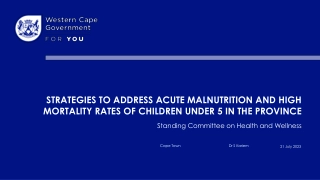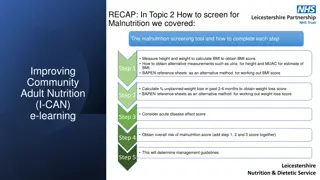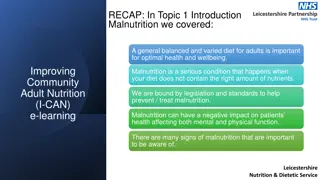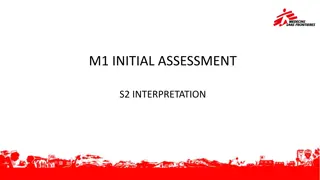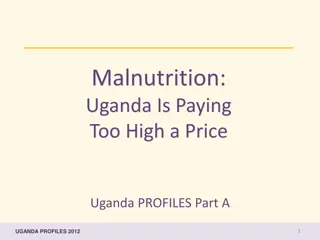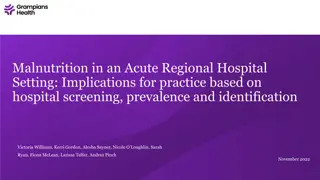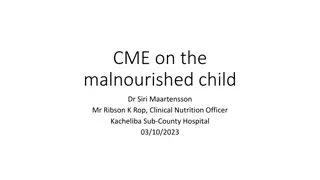Efficient Estimation and Planning for Malnutrition Caseloads
Recognize and establish methodologies for calculating supply caseloads, consolidate practices for estimating caseloads in malnutrition treatment, and make informed decisions on data selection to identify target caseload in the case study country. Find relevant info, estimate caseloads for SAM and MAM, and consider micronutrient deficiencies in population segments for effective planning.
Download Presentation

Please find below an Image/Link to download the presentation.
The content on the website is provided AS IS for your information and personal use only. It may not be sold, licensed, or shared on other websites without obtaining consent from the author.If you encounter any issues during the download, it is possible that the publisher has removed the file from their server.
You are allowed to download the files provided on this website for personal or commercial use, subject to the condition that they are used lawfully. All files are the property of their respective owners.
The content on the website is provided AS IS for your information and personal use only. It may not be sold, licensed, or shared on other websites without obtaining consent from the author.
E N D
Presentation Transcript
4.2 Case Study: Supply Caseload
Objectives Recognise the importance of agreeing definitions and methodology for calculating supply caseload with all partners. Consolidate knowledge and practice on procedures for estimating caseloads for treatment of acute malnutrition (MAM and SAM) Establish and agree on data when estimating caseloads.
Estimate caseload for SAM and MAM treatment activities in the Case Study country. Find relevant information / data in the background documents so far received. Take decisions on which information / data you will use for your calculations and justify your choice. Your objective is to identify the nutrition cluster s target caseload.
Caseload Estimations for SAM and MAM Population size (under-5) (Latest) SAM, MAM (or GAM) prevalence Correction factor (allows for estimation of incidence) Expected coverage
Example Estimating SAM Caseload Population Proportion 6-59 months SAM prevalence Correction factor Coverage 121,400 17.3 1.34 0.0134 2.6 100 21,002 281 1 732 Expected caseload
Example Estimating MAM Caseload Population Proportion 6-59 months MAM prevalence Correction factor Coverage 121,400 17.3 21,002 1071 5.1 1.5 100 0.051 1 1607 Expected caseload
Caseload Micronutrient Deficiencies Some tips: Micronutrient deficiencies: For 6-59 months (15-20% population) For Pregnant women (2.4% of population) For Lactating women (2.6% of population) Prevalence estimates ideally from national data/Unicef
Caseload IYCF-E Some tips IYCF-E: For 6-59 months (15-20% population) For 0 6 months For 6 23 months For Pregnant women (2.4% of population) For Lactating women (2.6% of population) Prevalence estimates ideally from national data/Unicef
Energy Requirements for Emergency-Affected Populations, Developing country profile (demography and anthropometry); Kilocalories per day Malea Femalea Male & Femalea Age/sex group (years) % of total population Energy requirement per caput % of total population Energy requirement per caput % of total population Energy requirement per caput 0 1.31 850 1.27 780 2.59 820 1b 1.26 1250 1.20 1190 2.46 1220 2b 1.25 1430 1.20 1330 2.45 1380 3b 1.25 1560 1.19 1440 2.44 1500 4b 1.24 1690 1.18 1540 2.43 1620 0-4 6.32 1320 6.05 1250 12.37 1290 5-9 6.00 1980 5.69 1730 11.69 1860 10-14 5.39 2370 5.13 2040 10.53 2210 15-19 4.89 2700 4.64 2120 9.54 2420 20-59c 24.80 2460 23.82 1990 48.63 2230 60+c Pregnant 3.42 2010 3.82 1780 285(extra) 7.24 1890 2.4 2.4 Lactating 500(extra) 2.6 2.6 Whole Populationc 50.84 2250 49.16 2010 2070 Sources: (1) Energy requirements derived from WHO Technical Report Series No. 724, 1985 (2) Population data (mid-1995): UN Population Division, New York
Key Messages Always involve partners in calculation of People in Need, your caseload and targets. Agree on definitions and methodology to calculate the caseload with all partners.



